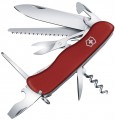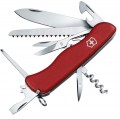Type of lock - a device for fixing the main blade - used in a folding knife (see “Design”). Theoretically, such a device should provide additional protection by preventing unauthorized closing (and sometimes opening) of the knife; however, in practice, much depends on the type of particular lock: different types can differ markedly in reliability, and there are solutions that do not provide for rigid fixation of the blade at all.
Among the most popular modern locks are
liner lock,
frame lock,
back lock,
axis lock,
button lock and
tri-ad lock, however, in addition to them, there are other options, including
double auto,
compression lock,
viroblock and
slip-joint. Let's look at both in more detail:
— Liner lock. One of the simplest, inexpensive and at the same time very reliable locks. The locking element is an elastic flat plate (“liner”) hidden inside the handle; when opening the knife, this plate moves to the side and supports the back of the blade, on which a special recess is provided for the liner. To disengage the lock and close the knife, the plate must be moved with your finger in the other direction, to its ori
...ginal position.
- Frame lock. In fact, it is a modification of the liner lock described above, in which the role of the locking plate is played not by the liner installed inside the handle, but by part of the handle itself. Such a lock is considered more reliable, and on the whole it is deservedly so: the part of the handle that supports the blade is much thicker than the “liner” and is less likely to shift when the lock is opened. Also, the advantages of a frame lock include a rather interesting and stylish appearance: knives with such locks are mostly all-metal, without handle linings; and models with linings differ in appearance from knives with other types of locks.
— Back lock. A lock using a locking plate, which looks like a kind of spring-loaded “rocker arm” installed along the knife handle and capable of swinging around a transverse axis. When the knife is open, this plate, with its leading edge, rests against the hook on the back of the blade, preventing it from closing; and to close the knife, you need to press on the part of the “rocker arm” protruding from the handle, releasing the plate from the hook. The pressing force is usually quite large, which minimizes the likelihood of disabling the lock even with the tightest grip. In general, such locks turn out to be quite reliable, but it is very difficult to close a knife with a “backlock” with one hand, and in many models it is even impossible.
— Axis lock. Benchmade's invention: a lock controlled by a special movable pin in the front of the handle. When moved forward, the pin enters a groove on the back of the blade, fixing it; when moved back, the lock is released and the knife can be closed. The pin is often made spring-loaded, and the blade, unlike many simpler solutions, is fixed not only in the open position, but also in the closed position. Thanks to this, Axis Lock is considered one of the most reliable modern locks. On the other hand, such a mechanism is sensitive to contamination and requires some care (however, simple) for reliable operation.
- Button lock. Another lock based on the use of a pin. However, in this case, the pin does not move in the longitudinal groove, but is controlled by pressing a button: this press releases the lock, allowing you to open or close the blade (most often it is fixed in both positions - open and closed). Also note that many knives with a “push-button” lock have an automatic opening mechanism - a spring-loaded blade that opens into the working position without effort on the part of the user.
— Virobloc. A knife lock developed by Opinel and still a “calling card” of knives of this brand. The key element of the lock is a rotating ring with a longitudinal slot installed in the front of the handle, at the point where it connects with the blade. To open or close the knife (and it is fixed in both the closed and open positions), you need to turn the ring so that the slot is opposite the blade - then the blade can pass through the ring to the desired position. If the slot is not opposite the blade, the latter, when trying to open or close, rests against the ring and cannot budge.
- Slip-joint. A type of knife lock that does not provide rigid fixation of the blade. In the open position, the blade in such a knife is fixed by the so-called spacer - an elastic element that is to some extent similar to the back lock “rocker arm”, but does not engage in a rigid engagement with the blade (and also plays the role of a kind of closer for a not fully open blade). To close such a knife, it is enough to apply some force to the butt. “Slip joints” are used mainly in small Swiss knives (see “Type”), not designed for high loads.
— Compression lock. A modification of the Liner Lock described above, created by Spyderco and used in some models of this company. One of the key differences from the original is that the locking plate is located on the top side of the handle rather than on the bottom. Due to this, as well as some specific design solutions inside the mechanism itself, the compression lock turns out to be much more reliable than the original “liner”, however, such a lock is not cheap.
— Levitator lock. A proprietary modification of the Frame Lock (see above), developed by Benchmade. Like the original “frame lock”, it is used in knives without pads. A distinctive feature of “levitators” is a specific pattern of slots in the middle part of the handle - this pattern forms a spring plate. A pin is attached to this plate from the inside, which, entering the hole on the back of the blade, fixes it (usually in both the closed and open positions). The lock opens by pressing the characteristic part of the pattern, which acts as a button.
- Arc lock. A proprietary development of the SOG Specialty Knives company, used in its knives; from a technical point of view, it is a slightly modified version of the axis lock described above. The control element is also a pin; and the key difference from the usual “axis” is that the pin is connected to a special rocker arm and moves not in a straight line, but in an arc. This provides additional reliability, however, such disadvantages of the original as high cost and sensitivity to dirt are also characteristic of such a lock.
- Double auto. The Double auto system is not so much a type of lock as a type of opening mechanism found in frontal knives (see “Design”). This mechanism is controlled by a sliding switch that can move in two directions - unfolding (forward) and folding (backward). The whole system works in this way: when the switch moves forward or backward, one of the springs is charged, and when the extreme point is reached, the blade is released and moves in the corresponding direction under the action of the charged spring. In general, this is a very convenient and practical, and therefore very popular type of lock among front-facing cameras.
- Safe lock. The full name is Ram Safe Lock. Developed by Cold Steel, a specific variation on the back lock theme (see above): it also uses a rocker arm to rigidly fix the blade, only in this case the rocker arm does not swing, but moves back and forth. The blade is fixed in the open and closed position; To open the lock, you need to pull the rocker by the back part protruding from the handle. This design is highly reliable and resistant to loads; Its main disadvantage is the inability to unfold and fold the knife with one hand.
— Cogwheel lock. “Gear lock”, also known as a ratchet lock. The rear part of the blade has the shape of a gear in such knives, and the locking occurs due to a plate with a cutout for one of the gear teeth. To open the lock, you need to lift the plate; For this purpose, a characteristic ring may be provided in the design. An interesting (although not very useful in practice) feature of ratchet locks is the ability to fix the blade not only in open and closed, but also in several intermediate positions. At the same time, the reliability of such devices is relatively low, so they are rarely used - in particular, in models that copy certain types of traditional knives (such as the Spanish Navaja).
- Slide lock. A relatively rare type of lock, found in certain models of Swiss knives - usually small, but advanced and multifunctional, where the additional mechanism does not particularly affect the dimensions. This lock is controlled by a slider on the side of the handle: the blade is fixed in the open position, and to fold it you need to pull the slider back, thus disabling the lock. The slider is spring-loaded, which does not allow it to “slide” back on its own (for example, under its own weight); In addition, the spring also plays the role of a closer for the blade that is not fully open. The reliability of “slide locks” is not particularly high, but this is not required given the specifics of the application.
— Tri-ad lock. An invention of the Cold Steel company, which is a variation on the Back Lock mechanism. It also uses a locking plate in the form of a characteristic spring-loaded “rocker arm”, but it is secured in the center by a floating pin (oval, not round). Next to the front end of the “rocker arm” there is another axial pin - together, these modifications have significantly improved the reliability of the locking mechanism. Thanks to such modifications, the blades of knives with Tri-ad lock are devoid of any backlash.The total weight of the knife. It is worth evaluating this indicator depending on the type (see above) and purpose: for example, for a compact hiking model,
light weight is usually a virtue, among hunting and fishing it all depends on specialization, and a machete, by definition, must be
weighty — otherwise, cut with such a blade it will just be uncomfortable.

